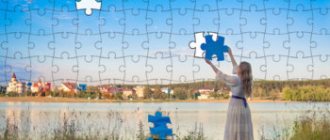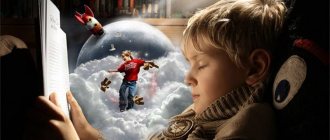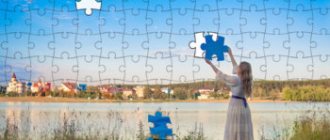Agglutination is the most important tool in psychology for assessing the state of an individual and his vision of the surrounding reality. The phenomenon of agglutination is very common in human nature and in the world in general. Sometimes observed in patients with schizophrenia or found in people suffering from speech disorders. The term agglutination describes the phenomenon that is the fusion of different elements (words, thoughts, images) into a single whole.
Agglutination in psychology is an imagination that is created by combining objects that exist in reality. This is a special type of connection, or rather merging, in which characteristics and traits that are absolutely uncombinable in objective reality are combined. A person’s imagination is essentially a dialogue that a person conducts with various parts of his “I”. Stimulants are various motives of vital necessity. Stimulation of the imagination itself is accomplished through human mental actions, which represent the formation of images.
Agglutination in psychology - examples are presented in fairy-tale images: centaurs (combining human features with the characteristics of a horse), sphinxes (features of a human face merge with the characteristics of a lion), mermaids (attaching a fish tail to the body of a beautiful woman), as well as other various mythological images. All these images appeared thanks to the rich human imagination. So, this very image of a centaur, most likely, was formed in conditions with poor visibility of a person jumping on a horse, so he seemed like some kind of fantastic animal. Also, the image of a man with wings appeared, apparently consciously, because it symbolizes the very idea of a person moving through the air, formed in such a sensual image.
The phenomenon of agglutination is a process that is related to psychology and is found in medicine and linguistics.
The process of agglutination in linguistics means the merging of different words into one, with a reduction in the morphological structure, while maintaining the original meaning. That is, agglutination in linguistics is a process in which different morphological elements of a language are combined into a whole, creating words.
What is imagination
Note 1
“Imagination” in psychology is understood as the process through which a person is able to create images and ideas in his mind.
Imagination is of great importance for the human psyche, as it plays an important role in such processes as:
- modeling
- planning
- creative activity
- memory
The process of imagination can be differentiated by the result; it can be: reproductive and productive. Reproductive is understood as imagination, during which images that already exist in reality are recreated. Productive imagination is the process by which something new comes into being.
Depending on the degree of purposefulness, the process of imagination can be voluntary or involuntary. Voluntary imagination consists of reconstructive and creative imagination, while involuntary imagination is unintentional and unpredictable.
Are you an expert in this subject area? We invite you to become the author of the Directory Working Conditions
Images, in turn, can be concrete and abstract, and imagination can be concrete and abstract.
Imagination performs a number of important functions. It allows a person to imagine the world around him in images, and makes it possible to use them to solve problems.
Imagination helps regulate emotions, cognitive processes and human states. Imagination provides the opportunity to think about and imagine in images a certain plan of action. It also allows a person to carry out planning, programming and evaluation of activities.
The following mechanisms of imagination are distinguished:
- agglutination
- hyperbolization
- schematization
- accentuation
- typing
Bottom line
Imagination, or fantasy, is a thought process that occurs both under the guidance of a person and without his participation. Imagination is a creative process that involves creating something that the world has not yet seen or is not familiar with. Usually new ideas and images are not introduced into real life because they are not consistent with natural laws. However, if a person is able to realize his idea, adapting it to real conditions, then the new thought becomes an innovation.
All this allows a person to experiment and make the world diverse. All this allows a person to feel like God. However, not everything is so simple, because sometimes agglutination is a consequence of a mental disorder in the processes of thinking or perception of the surrounding world. In this case, we are already talking about treating a person in order to rid him of hallucinations that he considers real and significant in his life. Here you cannot do without the help of a specialist.
Agglutination as a mechanism of imagination
Agglutination is the process of creating a new image from parts of other convoys. This process provides a lot of information about a person's personality. The human personality is a rather complex mechanism. A person has intellectual abilities; a thought process is always going on in his mind. Everything that exists in the world is either created by nature or created thanks to man. Man has an amazing ability: he can create something completely new and unique.
Finished works on a similar topic
Course work Mechanisms of imagination 460 ₽ Essay Mechanisms of imagination 260 ₽ Test work Mechanisms of imagination 230 ₽
Receive completed work or specialist advice on your educational project Find out the cost
There are many examples of agglutination among fairy-tale creatures: a centaur is a combination of the upper part of a human body and the lower part of a horse, a mermaid is the upper part of a woman, and the bottom is a tail, a hut on chicken legs, and so on.
Agglutination represents what happens during the mental activity of every person. The process of agglutination occurs in almost all people, both healthy and unhealthy. It is especially common in people suffering from schizophrenia.
Agglutination is considered an automatic action; we can only see the result of agglutination, but we cannot see the process itself, since it is inside the human consciousness. In order for the agglutination process to take place, a person needs a supply of experience. But nevertheless, agglutination is not an arbitrary process, that is, a person does not specifically turn to his experience, but unconsciously and spontaneously.
As we know, a person’s imagination is enriched by human experience; the more a person has learned and seen in his life, the more widely developed his imagination is, the more new images he can produce.
Agglutination in its origin is not accidental; its images are obtained from what is embedded deep in a person’s subconscious. The process itself is divided into two parts:
- elements are not criticized or analyzed.
- components must influence mental generalization in order to build a whole image.
Using agglutination in creativity
In art, many imaginative techniques - agglutination, emphasis - are often used. For example, Leo Tolstoy admitted that the image of Natasha Rostova from the novel “War and Peace” was based on two real women – his wife Sophia and her sister, Tatyana Bers. The combination of two types of women - one impetuous, lively and enthusiastic, and the second feminine and gentle - helped to give birth to an integral and absolutely vital character.
Sharpening, or emphasizing attention, no less helps to achieve a memorable result. Cartoonists especially love this technique. The depiction of a chatterbox as a person with an excessively long tongue, or a beer drinker with a huge belly, allows us to emphasize the most significant in the appearance and habits of the people depicted in the picture.
In literary works, the emphasis is placed at the moment of describing the hero. Focusing the reader's attention on any of his qualities allows him to convey the essence of the character's nature without further ado and even determine the author's attitude towards him.
Hyperbolization as a mechanism of imagination
The term “hyperbolization” is understood as the process of exaggerating or minimizing an object or parts of an object. In other words, these are fantasies about an unusual creature that acquires qualitatively new properties. Hyperbole is often used in fairy tales. Examples of hyperbolization are giants, gnomes, Thumb, Gulliver, the many-armed Indian god, Cyclops, Serpent Gorynych, Dwarf Nose, Thumbelina. Some scientists consider the process of hyperbolization to be one of the types of emphasis.
Note 2
Also, some scientists share the concept of hyperbolization and litotes: hyperbolization is an exaggeration of an object, and litotes is an understatement.
Once again about what agglutination is
The work of the human imagination, as is clear from the above, uses a rather limited number of techniques - agglutination, accentuation and typification. But even with such a small arsenal, it is capable of a lot.
Thus, agglutination in psychology is not only a method of creating an artistic image on a canvas or in a literary work, but also the possibility of implementing completely new ideas in science and technology. Creative imagination allows the inventor to first mentally assemble disparate details into a single whole, and then apply this in practice, making discoveries and advancing progress.
Schematization as a mechanism of imagination
“Schematization” is understood as the process of smoothing out the differences that objects have and searching for similarities. In this case, secondary elements are cut off. Individual characteristics are also ignored.
An example of schematization could be an ornament created by an artist in which elements of plants were used.
Schemas are a series of interconnected thoughts. Schematization can be represented by several types:
- taking notes
- infographics
- illustrated chart
- algorithmic graph
- conceptual schematization
Manifestations of agglutination in psychiatry
Unfortunately, agglutination in psychology is also a term that denotes one of the symptoms of exacerbations of schizophrenia.
It refers to a condition in which the patient loses the ability to distinguish between certain concepts, since they are glued together in his brain. By the way, thanks to this, a large number of neologisms appear in the vocabulary of such people (a person will come up with completely new words or give old ones new meanings).
The process of agglutination leads to the fact that a patient with schizophrenia has a disrupted perception of his own “I” and the surrounding reality. For example, in some cases, patients are unable to distinguish themselves from other people or even objects. And what is happening in the outside world in their imagination is closely intertwined with some bodily functions (for example, rain is their tears, etc.)
Emphasis as a mechanism of imagination
The concept of “emphasis” is understood as the process of emphasizing certain specific features of an object. In this case, a change in the proportions of the object may occur. Accentuation, in other words, is called sharpening.
Examples of emphasis can be caricatures - a type of art that ridicules ideas, vices, phenomena, people using stereotypes, caricatures - a type of art similar to a caricature, but there is no purpose to ridicule, only an emphasis is placed on certain specific features.
The concept of emphasis includes the concepts of hyperbolization (exaggeration of the properties of an object) and litotes (decreasing the properties of an object).
Types of agglutination
- True agglutination . The sperm themselves have an irregular structure and stick together.
- Nonspecific agglutination (physiological aggregation). Sperm have normal structure and properties, but stick together with seminal fluid. Sperm are active, but their motility is reduced.
- Mixed agglutination . A combination of the two previous factors. It is rare and causes a more severe form of infertility.
Forecast
In approximately every 3rd case, over time, all unpleasant symptoms are relieved and the patient feels like a full-fledged member of society.
Another significant proportion of such patients demonstrate moderate remission, with an almost complete absence of manifestations of the disease (including unhealthy agglutination). Success in treatment depends on the timeliness of identifying the problem and the complexity of the approach to treatment - a combination of psychocorrection with drug treatment.
If there is a favorable environment in the family and all the doctor’s recommendations are followed, it is possible to avoid acute manifestations of the disease (delusions, hallucinations), as well as to prevent the patient’s social degradation, which is expressed in an increased tendency in such patients to:
- taking drugs;
- drinking alcohol;
- suicide.
Agglutination is a unique form of thought process that allows a person to discover new things by processing previously received information.
In psychology, agglutination can be considered as a useful tool that allows a mentally healthy person to develop, as well as a symptom of serious mental disorders. As a rule, these deviations do not occur often, so agglutination largely helps people improve their experience and find new answers when solving various problems.
Techniques
What are the techniques of imagination?
Agglutination
Agglutination is an operation in which elements related to different phenomena or objects are combined to create something new.
This technique can often be found in mythology, fairy tales and legends of different peoples of the world, in works of art written in the genres of fantasy and science fiction.
Examples of agglutination:
- Sea maiden. Traditionally, sea maidens are attractive girls with a fish-like tail instead of legs, existing in European mythology. In Russian they are usually called mermaids, despite the fact that classic mermaids, taken from Slavic mythology, do not have a tail.
- Sphinx. This mythical creature became quite famous, and many peoples depicted it in different ways. The most famous image of the Sphinx is a creature with the body of a lion and a human head.
- Centaur. A famous mythical creature - half man, half horse - that has migrated from myths to many famous fantasy universes, for example, to the Harry Potter universe.
- A hut on chicken legs. An ominous attribute in many Russian folk tales: a hut standing on strong legs (two or four) reminiscent of chickens, often able to move with their help and behaving like a relatively intelligent creature.
- Animals from the popular animated series Avatar: The Last Airbender and Avatar: The Legend of Korra. In the fantasy universe of these animated series, there are a huge number of animals created using the “agglutination” technique: mole badgers, lion turtles, rabbits (rabbit and kangaroo), turtle crabs, platypus bears and many others.
- Hippogriff from the Harry Potter series of books and films. According to the description in the books, the hippogriff is a large animal that is a mixture of a horse (torso, tail and hind limbs) and an eagle (head, wings and forelimbs). May have different colors.
From Latin the word “agglutination” is translated as “sticking.” This term is used not only in psychology, but also in biology and linguistics, and has different meanings.
Hyperbolization
Hyperbolization - a phenomenon or creature is deliberately depicted as larger or smaller so that its image works in the context of the story being told, creates certain emotions, and looks more or less significant compared to others.
The number of elements that are part of the object can also be increased or decreased.
This technique is also often found in mythology, fairy tales , science fiction or fantasy settings.
Examples:
- Thumbelina. The tiny size of the girl from Andersen's fairy tale made it possible to realize the plot that was presented (interaction with small animals and insects on equal terms) and to emphasize her vulnerability.
- A dragon with several heads. In many stories and fairy tales, dragons have more than one head: usually there are three, or seven, or twelve. Since dragons are traditionally represented in fiction as negative characters that must be defeated, the number of heads emphasizes the danger posed by them and makes it difficult for the protagonist to fight.
- Many-armed Indian gods. Many Indian deities are depicted with many hands. Their hands symbolize their power and ability to do many things at the same time. In some cases, philosophical connotations are attributed to additional hands.
Other examples include other creatures, such as the god Janus, who has two faces, or the Cyclops, who has only one eye.
Addition
Addition - some object (often a material object) is given characteristics that are not the norm for it in everyday life.
Examples of the use of such an operation can also be easily found in many fantasy works of art.
Examples:
- Invisible hat. Makes the one who wears it completely invisible. The invisibility cloak from the Harry Potter series of books has a similar skill.
- Self-assembled tablecloth. A special tablecloth that can materialize an unlimited amount of delicious and varied food, you just need to spread it and say the magic words.
- Magic wand. In earlier works of art, such wands simply fulfilled the owner's wishes when waved.
For example, in the Harry Potter series, the magic wand became a tool that releases the wizard's power. The staves of magicians, which appear in many fantasy universes, have similar skills.
Other examples : seven-league boots, flying carpet.
Typing
Typification is a technique in which the characteristics of similar objects, phenomena, people belonging to the same group are collected and used to create a unique image that is a reflection of a certain reality.
Typification is common in many works of classical literature: some famous characters represent a combination of such traits that reflect the problems and essence of individual groups of the population, becoming a mirror of their century, era.
Examples:
- Faust;
- Eugene Onegin;
- Mitrofanushka from the play “The Minor” by D. I. Fonvizin;
- Landowners from the work “Dead Souls” by Gogol (Korobochka, Manilov, Nozdryov).
Accenting
Emphasis is a technique in which individual characteristics of a character or other creature are emphasized, often excessively, necessary for ridicule or greater expressiveness.
Examples:
- Caricatures. This type of art is aimed at ridiculing various phenomena, ideas, personalities, historical events, and vices of society, often in a rude manner, using black humor and stereotypes. Cartoonists focus on those features that they seek to ridicule. For example, a chatterbox might have a long tongue.
- Cartoons. This type of art has a direct connection with caricature, but does not ridicule anything, it only focuses on the external characteristics of a person or animal. Typically, a cartoon is a recognizable portrait in a humorous style, implausibly exaggerating individual features of the object. The cartoons bring a smile and a good-natured laugh to those who look at them.
Transfer
Transfer (or displacement ) is a technique in which a creature or other object is placed in non-standard conditions in which it should not have been placed.
As an example, we can cite characters who in the fan community are called “accidents” : these are either unusual, fairy-tale heroes who find themselves in our world and adapt to life in it, or ordinary people who, by chance, find themselves in a fantastic or fantasy universe.
Examples of famous people:
- Old Man Hottabych. The story of an ancient genie who found himself in Soviet realities and met the boy Volka is known to most of those who were born in the nineties and earlier.
- Children from the Narnia series created by Clive Lewis. A fantasy classic that sits alongside the works of Tolkien.
It also makes sense to remember Alice who found herself in Wonderland, Dorothy (who became Ellie in Volkov’s adaptation) and many others.
The very idea of zoos can be attributed to displacement : animals find themselves in non-standard conditions.
Analogy
Analogy - an original image is created on the basis of something that is already present in reality and has the necessary abilities.
Examples:
- Airplanes and other devices designed for flight were created based on observations of birds and animals that glide with the help of wings (flying squirrels).
- An analogy for radars and locators is the mouth and ears of bats, with the help of which they navigate.
Diagnosis of the problem
A doctor can make a diagnosis of “agglutination” only based on the results of a spermogram.
To find out the causes of the pathology, a number of examinations are prescribed. If there are no more than two pluses in the “agglutination” column in the spermogram, then natural conception is possible. With the third and fourth degrees of pathology, asthenozoospermia (reduced mobility) can be diagnosed, and the reasons that caused this type of pathology are further investigated. To clarify the diagnosis and prescribe an examination plan, it is first necessary to conduct a repeat spermogram at intervals of 2–3 weeks in order to cover different stages of spermatogenesis. You should carefully prepare for the test. A false result may occur if, in preparation for the test, a period of abstinence was not maintained, alcohol was consumed, and other preparation rules were violated. When taking the test again, it is extremely important to maintain exactly the same period of abstinence as in the first case.
If both spermograms demonstrate a similar clinical picture, it is recommended to conduct several more studies:
- MAP test is an analysis for the presence of antisperm antibodies, which examines samples of sperm (direct test) or blood (indirect). The latter option is less informative, but is used in cases where it is difficult to obtain ejaculate samples;
- bacterial culture of sperm for the diagnosis of bacteriological infections.
Treatment
If we are talking about agglutination, as a result of which new interesting, non-destructive ideas are born and useful ideas are realized, then this type of mental activity does not require any treatment.
On the contrary, this may indicate the harmonious development of the individual and her ability to comprehensively apply her experience and develop her imagination.
In the case when a person has speech disorders associated with mental disorders or is diagnosed with schizophrenia, then such a person should be provided with comprehensive assistance from specialists, otherwise the process of agglutination in such people can lead to sad consequences both for themselves and for their environment.
Until now, the concept of treating this type of deviation causes a lot of controversy among specialists, since there are no uniform approaches to the treatment of this condition. Most experts believe that schizophrenia can be treated on an outpatient basis, resorting to hospitalization only in severe forms. Treatment methods include drug therapy, as well as psychocorrective work with the patient.
Medication
The symptoms that accompany the process of agglutination in speech disorders and schizophrenia are, for the most part, amenable to medication adjustment.
American psychiatrists generally recommend using atypical neuroleptics for the treatment of such patients, which act specifically on the negative signs of the disease. At the same time, they note the importance of an individual approach and optimization of treatment regimens for each patient.
To treat such patients, medications such as:
- Clozapine;
- Risperidone;
- Olanzaline;
- Amisulpride.
Patients should continue to take these medications after the acute attack has stopped, in order to maintain remission and minimize the risks of exacerbation of the disease.
When using these medications, 40-50% of patients respond positively to therapy, 30-40% respond slightly worse, and only 20% of patients do not have the desired effect. Also, these medications reduce the negative phenomena characteristic of this disorder, reducing the tendency and craving in such patients for suicide, drug addiction, and alcoholism.
Psychotherapy
If agglutination is a symptom of a disorder, psychotherapy is often used to correct the condition, which is carried out in combination with drug therapy. Only medication relief of the symptoms of the disease will not be able to fully return the patient to full social and professional activities.
To work with such patients use:
- cognitive behavioral therapy – this technique has a solid evidence base and can reduce the number of relapses of the disease in patients. Its essence lies in working through the patient’s false destructive attitudes and reconfiguring his mental activity in the right direction;
- family therapy - when the patient interacts with the psychiatrist not alone, but together with his family. The specialist’s task is to identify problematic issues, resolve them and establish a normal healthy microclimate in the family, which will reduce the risk of exacerbation of the disease in the patient.
These techniques help patients better understand their condition and reduce episodes of delirium and hallucinations. The disadvantage of these approaches is their high cost, since such classes are conducted on an individual basis and are not cheap.











